|
|
|
Sort Order |
|
|
|
Items / Page
|
|
|
|
|
|
|
| Srl | Item |
| 1 |
ID:
107714
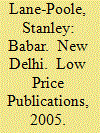

|
|
Babar
/ Lane-Poole, Stanley
|
2005

|
|
|
|
| Publication |
New Delhi, Low Price Publications, 2005.
|
| Description |
206p.
|
| Standard Number |
8175363525
|
|
|
|
|
|
|
|
|
|
|
|
Copies: C:1/I:0,R:0,Q:0
Circulation
| Accession# | Call# | Current Location | Status | Policy | Location |
| 054917 | 954.02/LAN 054917 | Main | On Shelf | General | |
|
|
|
|
| 2 |
ID:
126161
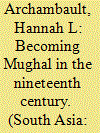

|
|
|
|
|
| Publication |
2013.
|
| Summary/Abstract |
In 1861, Nawab Sikandar Begum, the female ruler of Bhopal, toured Northern India for six months. The journey and its narration in the Taj al-iqbal (1873) were part of a broader project of princely self-fashioning aimed at both indigenous and British audiences. Taking the example of the Begums of Bhopal, this article engages with debates about travel and its relevance to the emergence of a nationalist imaginary, but also of its continuity with alternative visions in the latter half of the nineteenth century. The paper draws upon the insights of revisionist literature on princely states, which stress that princes at the mercy of British power nevertheless remained figures of indigenous authority, retaining a precarious autonomy in their territories. The Begums of Bhopal were able to turn their status as 'loyalists' towards consolidating a 'Mughal' aesthetic by recruiting artists, scholars and poets to underscore the state's autonomy.
|
|
|
|
|
|
|
|
|
|
|
|
|
|
|
|
| 3 |
ID:
114919
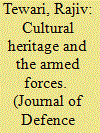

|
|
|
|
|
| Publication |
2012.
|
| Summary/Abstract |
Imagine if there is a war between India and Pakistan and the National Museum at New Delhi was vandalized and precious historical artifacts and other historical objects were stolen; or close your eyes and visualize India without the Taj Mahal which may be destroyed in an air attack. The standing bodhisattvas, dating back to seventh century AD, and the arms and armours of the Mughal era are some of the fabulous cultural wealth stored in the National Museum that is priceless for the nation and the loss of which can be the loss of the entire golden history of that era. That is literally what has happened to the Iraq National Museum in Baghadad (the Archaeological Institute of America has raised concern on the subject). Many artifacts contained in the museum were excavated from what has come to be known as the "Cradle of Civilisation" and artifacts-like a Sumerian marble head of a woman from Warka, dated 3000 BC and measuring 20 cm high-were found stolen from the National Museum in Baghdad. The fog of war and the instability that followed led to the looting and disappearance of thousands of such priceless artifacts from Baghdad National Museum and have sent alarm bells ringing regarding the preservation of cultural heritage in any armed conflict. The Chinese Cultural Revolution was another example of what harm can be done to the cultural heritage and how history can be obliterated and precious artifacts destroyed in the event of hostility breaking out.
|
|
|
|
|
|
|
|
|
|
|
|
|
|
|
|
| 4 |
ID:
101236
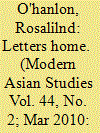

|
|
|
|
|
| Publication |
2010.
|
| Summary/Abstract |
Maratha Brahman families migrated to Banaras in increasing numbers from the early sixteenth century. They dominated the intellectual life of the city and established an important presence at the Mughal and other north Indian courts. They retained close links with Brahmans back in the Maratha regions, where pressures of social change and competition for rural resources led to acrimonious disputes concerning ritual entitlement and precedence in the rural social order. Parties on either side appealed to Banaras for resolution of the disputes, raising serious questions about the nature of Brahman community and identity. Banaras pandit communities struggled to contain these disputes, even as the symbols of their own authority came under attack from the Mughal emperor Aurangzeb. By the early eighteenth century, the emergence of the Maratha state created new models of Brahman authority and community, and new patterns for the resolution of such disputes.
|
|
|
|
|
|
|
|
|
|
|
|
|
|
|
|
| 5 |
ID:
001543
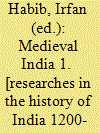

|
|
|
|
|
| Publication |
DelhI, Oxford University Press, 1999.
|
| Description |
vii, 224p.pbk
|
| Series |
Centre of Advanced Study in History
|
| Standard Number |
0195646584
|
|
|
|
|
|
|
|
|
|
|
|
Copies: C:1/I:0,R:0,Q:0
Circulation
| Accession# | Call# | Current Location | Status | Policy | Location |
| 041112 | 954.02/HAB 041112 | Main | On Shelf | General | |
|
|
|
|
| 6 |
ID:
001585
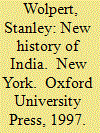

|
|
|
|
|
| Publication |
New York, Oxford Univ. Pr., 1997.
|
| Description |
ix, 513p.: mapspbk
|
| Standard Number |
019510031X
|
|
|
|
|
|
|
|
|
|
|
|
Copies: C:1/I:0,R:0,Q:0
Circulation
| Accession# | Call# | Current Location | Status | Policy | Location |
| 041146 | 954/WOL 041146 | Main | On Shelf | General | |
|
|
|
|
| 7 |
ID:
121943
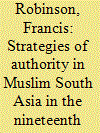

|
|
|
|
|
| Publication |
2013.
|
| Summary/Abstract |
Starting from the position that authority is constantly a work in progress, this paper examines authority in Muslim South Asia at a time when Muslims felt the challenge of rule by another civilization. It examines the strategies in sustaining their authority: of religious leaders, of Unani hakims and of literary leaders. In all three areas there is a rejection of the Persianate Mughal past and an embracing of Arab models, of the Prophetic model, and in various ways a drawing on British models and British authority. The paper also looks at the strategies of the rulers noting, amongst other things, how the British drew heavily on Mughal models just as Indian Muslims were letting them go, and how, since independence, Muslim rulers have drawn on a mixture of Western, Arab and Prophetic sources. There is also a running discussion throughout the paper of the revolutionary shift towards rooting authority in society at large, and the development of techniques to do so.
|
|
|
|
|
|
|
|
|
|
|
|
|
|
|
|
| 8 |
ID:
186288
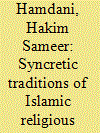

|
|
|
|
|
| Publication |
Oxon, Routledge, 2021.
|
| Description |
xvi, 216p.hbk
|
| Standard Number |
9781032189611
|
|
|
|
|
|
|
|
|
|
|
|
Copies: C:1/I:0,R:0,Q:0
Circulation
| Accession# | Call# | Current Location | Status | Policy | Location |
| 060208 | 297.5/HAM 060208 | Main | On Shelf | General | |
|
|
|
|
| 9 |
ID:
159381
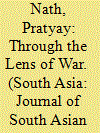

|
|
|
|
|
| Summary/Abstract |
The present article is a study of the process of Mughal empire-building in early modern North India using war as the point of entry. Specifically, it focuses on three sieges from the early years of Akbar's reign—Chitor (1567–68), Ranthambhor (1569) and Kalinjar (1569). It teases out certain aspects of these sieges and discusses them at length individually. Bypassing historiographically-popular themes like combat and technology, it explores less-probed issues such as the fate of defeated enemies, the involvement of zamindars and mansabdars, military finance and the role of quasi-military labour in imperial military campaigns. In the process, it strives to write a social, cultural and economic history of Mughal military expansion focused primarily on the second half of the sixteenth century.
|
|
|
|
|
|
|
|
|
|
|
|
|
|
|
|
| 10 |
ID:
108031
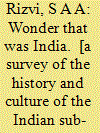

|
|
|
|
|
| Publication |
London, Picador, 1987.
|
| Description |
Vol. 2; xxxv, 416p.
|
| Standard Number |
9780330439107
|
|
|
|
|
|
|
|
|
|
|
|
Copies: C:1/I:0,R:0,Q:0
Circulation
| Accession# | Call# | Current Location | Status | Policy | Location |
| 056242 | 954/RIZ 056242 | Main | On Shelf | General | |
|
|
|
|
|
|
|
|
|